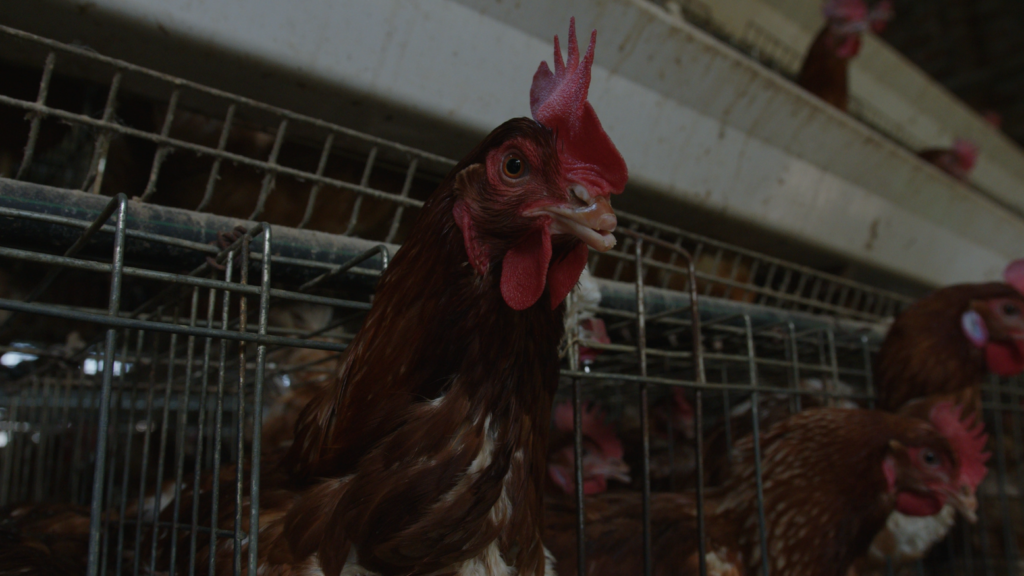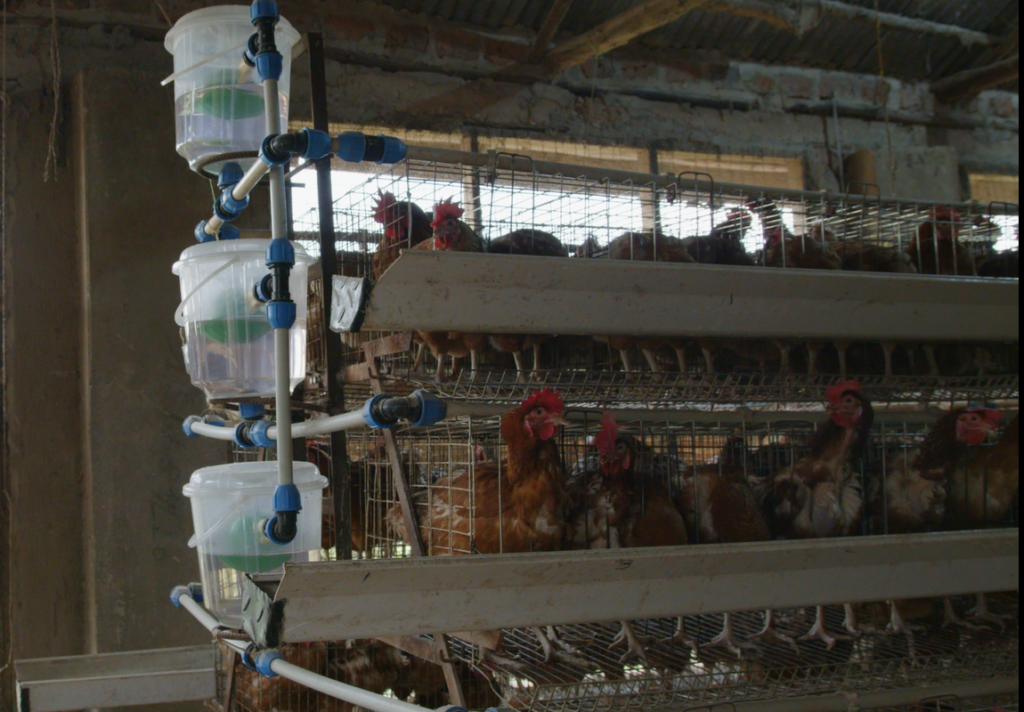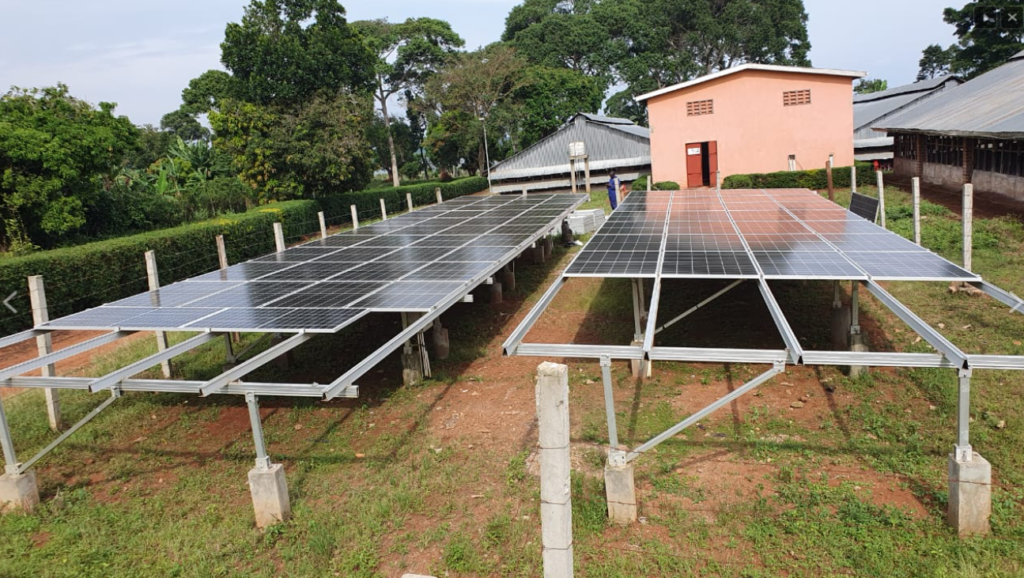Powering Output:
Farmers in Ugandan Off-grid Villages Reap Big, Thanks to Clean Energy Credit
Written by: Rhonet Atwiine.
Written by: Rhonet Atwiine.
As the night falls, the lights at Alex Byamukama’s farm go up, illuminating the chicken coops and the neighboring Kikuuta village, a remote community in Buikwe district, central Uganda.
The farm’s solar-powered equipment runs all through the day to support the production of feeds, alongside giving enough light all over the farm at dusk.
“I no longer incur exorbitant electricity costs. I used to spend more than 200,000 shillings on electricity monthly. Whether I have power or not, the farm continues to run. I love it because it’s cheap and reliable” says Byamukama.
Byamukama’s poultry farm has over 50,000 chickens, in 8 coops. On a good day, he produces 3000 eggs consumed locally.
However, to maintain the farm’s daily productivity, he must ensure that operations run efficiently. This means feeding the chickens on time to reach optimal market weight and providing a suitable environment for the egg-laying hens to thrive.
“Without reliable power, we would struggle to keep up with these demands, affecting our ability to sustain our daily production,” Byamukama explains.
Byamukama received the solar installation two years ago from Aptech Africa, an energy solution enterprise which provides farmers in remote off grid communities with solar energy to improve farm yields.
By then, his farm was supplying about 1000 eggs to the market. That has since tripled. Aptech Africa’s concept is to make solar panels more accessible to livestock farmers through a subscription model.
Through this, farmers receive solar panels and pay in installments over a two-year period until the system is fully paid off.
This model helps ease the financial burden of the upfront cost, enabling farmers to run their farms more efficiently without the high expense of traditional solar installations.
“Solar can seem expensive—depending on the size of the farm, it can cost up to 10 million shillings. That amount often scares people away, but they forget it’s a one-time investment lasting about 25 years. After the initial cost, there’s little to spend,” Kamoga explains.

A peek into Alex Byamukama’s chicken coop. Courtesy Photo.
In Uganda, poultry production is considered one of the major components of the agricultural sector. The Uganda Bureau of Statistics states that the country is home to more than 36 million birds.
Among these, eighty percent (80%) of the birds are of indigenous breeds kept under free range, while 20 percent are raised in commercial production systems.
Chickens are the most popular domesticated animal in Uganda and provide a regular source of eggs and meat of about 65 metric tonnes to a large share of the population of 45.5 million.
Energy is a key ingredient in poultry production because it serves functions such as feed production and warmth for chicks. However, high electricity tariffs, unreliable power supply and off grid connections especially for remote communities is limiting farmers from maximizing poultry production.
While access to electricity is gradually improving across the country, only 57% of the population has access, including grid and off-grid connections.
Over 70% of Uganda’s population resides in rural and remote areas, and the existing grid infrastructure doesn’t reach them, resulting in a substantial portion of the population without access to electricity.
Currently, only 19% of Uganda’s population has access to the national electricity grid, while 38% rely on off-grid solutions, primarily solar power. As a result, the majority of people depend on solar energy for their daily activities.

A chicken coop at Alex Byamukama’s farm in Kikuuta village. Courtesy Photo.
Aptech starts with taking up an energy needs assesment of a farmer and everything at their farm.
Once all this information is gathered, precise measurements are taken to design a system that meets the farm’s energy demands.
For a farm as large as Byamukama, the primary installation method involved a ground-mounted 22.78 kWp solar PV system to meet the farm’s energy demands.
He recently upgraded the system by installing 67 monocrystalline Solar Power panels, each with a capacity of 340W.
These are high-efficiency panels that replaced older ones that had frequent issues due to variations in brand and quality, which caused them to burn out quickly
With over 20% efficiency, the system provides a constant and reliable power supply. It also powers a solar water pump, lighting, and feeding motors, ensuring smooth operations across the farm.
As an off-grid setup, the system relies entirely on solar energy, making the farm independent of the national grid and eliminating worries about electricity outages.
Beyond poultry farming, the use of solar panels has gained popularity in agriculture, particularly in rural communities.
Farmers have adopted solar water pumps for irrigation, solar-powered refrigerators to reduce post-harvest losses, and solar fishing lights that allow them to fish during the wee hours.

A solar panel system set by Aptech Africa at Alex Byamukama’s farm. Courtesy photo
While solar panel systems contribute to economic growth, there are still gaps in implementing renewable energy policies, particularly regarding taxation.
According to the 5th Schedule of the East African Community Customs Management Act, 2004, specialized equipment used for the development and generation of solar and wind energy, including those that store or utilize power, are exempt from all taxes.
Exempted items include deep cycle batteries, solar panels, direct current inverters, and charge controllers. However, in practice, this is not consistently applied.
Julius Kabenge, a solar panel wholesaler, explains that various government agencies enforcing these policies often lack a clear understanding of what the policies truly entail.
“For instance, you might import a container of solar panels and batteries, and the Uganda Revenue Authority (URA) won’t charge you the first time. But when you bring in the same items again, they’ll want to impose taxes. There’s a real inconsistency there. If something is supposed to be tax-free, then it should apply every time, not just once. That’s a significant gap,” Kabenge highlights.
When such items are taxed, it shifts the financial burden onto farmers like Byamukama, who end up paying far more than they anticipated. In addition to taxes, Byamukama notes that weather patterns also affect the solar system’s performance.
“Solar panel systems are most effective during sunny seasons, but less reliable in rainy seasons. If there’s no sunshine, I must rely on paid electricity, increasing my costs.”
Despite these challenges, Byamukama is optimistic about the potential of solar technology and continues to learn. He plans to expand his use of solar energy.
“I believe the future of poultry farming is very promising, and with solar, everything gets brighter. I’m excited to start more agricultural projects and install additional solar-powered technologies, like a solar dryer and an irrigation system,” he concludes.
This story was produced with the support of the African Centre for Media Excellence in partnership with the Charles Stewart Mott Foundation.
© 2022 - Media Challenge Initiative | All Rights Reserved .
© 2022 - Media Challenge Initiative | All Rights Reserved .